Sunday, April 2nd 2017

Aqua Computer Also Announces the kryoM.2 EVO Performance SSD Cooler and Riser
Almost one year ago Aqua Computer launched the kryoM.2 for the first time: an adapter card with passive heat sink for M.2 SSDs. The popularity of M.2 SSDs continues to grow and the thermal problems of these small ultrafast drives will continue too. Aqua Computer has put a lot of development energy into an improved version: the kryoM.2 evo.
The kryoM.2 evo is a high-quality PCIe card that is capable of maximizing the performance of M.2 SSDs. To achieve this, Aqua Computer drastically increased the size of the main heat sink. A second smaller heat sink has been integrated to the backside of the board. This patent-protected system encloses the SSD between these two heat sinks and also cools it from both sides.Key features of kryoM.2 evo:
Delivery will begin in early April, but orders can be already placed in Aqua Computers Webshop. The price for the kryoM.2 evo is 34.90 Euro. The previous kryoM.2 adapter is not replaced by the evo series and remains available.
The kryoM.2 evo is a high-quality PCIe card that is capable of maximizing the performance of M.2 SSDs. To achieve this, Aqua Computer drastically increased the size of the main heat sink. A second smaller heat sink has been integrated to the backside of the board. This patent-protected system encloses the SSD between these two heat sinks and also cools it from both sides.Key features of kryoM.2 evo:
- Large passive cooler with improved cooling capacity for the upper side of the SSD
- First-time integrated heat sink for SSD back-cooling
- Configurable LED lighting and additional activity indicator on the backside
- Silicone mat protects the SSD from environmental influences and serves as a light guide for the LEDs
- Impedance controlled for high signal quality, high data rates and to avoid read/write errors
- PCIe connector with hard gold coating
- Fully gold-plated PCB
- Slot panel with improved ventilation
- LEDs permanently on
- LEDs permanently off
- LEDs are controlled by the activity of the SSD
Delivery will begin in early April, but orders can be already placed in Aqua Computers Webshop. The price for the kryoM.2 evo is 34.90 Euro. The previous kryoM.2 adapter is not replaced by the evo series and remains available.
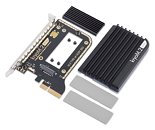
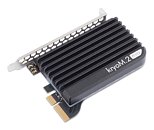
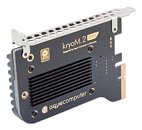
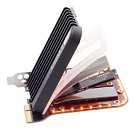
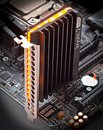
16 Comments on Aqua Computer Also Announces the kryoM.2 EVO Performance SSD Cooler and Riser
I'm not sure how encasing something in metal helps cooling, I'd like to see tests first.
Source: www.overclock.net/t/1591795/build-log-caselabs-mercury-s5-projectevo/50_50#post_25172007